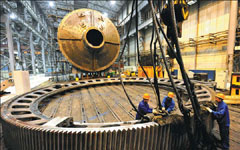"We expect Beijing to launch a series of policy measures to stabilize growth. Likely options include lowering entry barriers for private investment; targeted spending on subways, air cleaning and public housing, and guiding lending rates lower," Qu said.
Zhang Zhiwei, chief China economist with Japan's Nomura Securities, said the decline in the flash HSBC PMI surprised the market since consensus stood at 48.7.
The positive market expectations were likely due to the seasonal effect and the rebound of another economic indicator - the MNI business sentiment index - to 53.4 in March from 50.2 in February.
 |
|
 |
"We maintain our view that growth momentum will slow in the first half of the year, and policy easing will pick up in the second quarter," he said in a research note.
Zhang also maintained that China is likely to cut the reserve requirement ratio twice in the coming quarters. Fiscal policy will also likely become expansionary in the second quarter to keep GDP growth from dropping below 7 percent.
Nomura forecasts that China's economic growth could slow down to 7.3 percent in the first quarter and further to 7.1 percent in the second quarter, lower than the government's annual expansion target and the 7.7-percent growth in the last quarter of 2013, according to Zhang.
Qu Hongbin also said March's PMI reading indicated that growth in the first quarter could probably be below 7.5 percent, and could even challenge the 7-percent "growth floor" and hit the job market.
In an earlier research note, Qu said almost all economic figures released so far this year were weaker than market consensus.
The HSBC manufacturing PMI for February was 48.5, but the average reading for January to February came in at 49.0. This suggests that China's manufacturing sector is losing momentum, and the official manufacturing PMI repeated the same message, he said.
Qu said China's external demand has also been erratic. On the domestic front, industrial production, fixed asset investment and retail sales data for the first two months were all weaker than forecasted.
"This calls for immediate policy action to put a floor on the growth slowdown," Qu argued.
